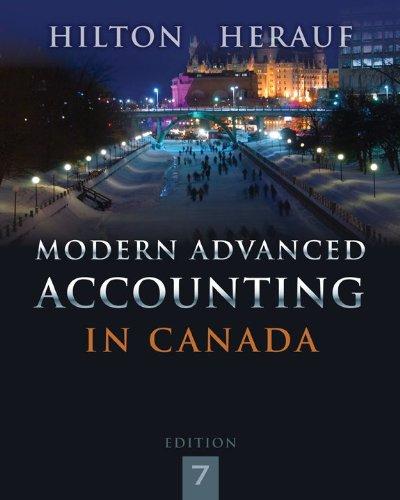On January 1, Year 1, Porter Inc. purchased 85% of the voting shares of Sloan Ltd. for
Question:
€¢ Plant and equipment (net) had a fair value $200,000 greater than its carrying amount. The remaining useful life on January 1, Year 1, was 20 years with no anticipated salvage value.
€¢ Accounts receivable had a fair value $75,000 less than carrying amount.
€¢ Long-term liabilities had a fair value $52,680 less than carrying amount. These liabilities were issued at par and mature on December 31, Year 10.
Additional Information
€¢ Between January 1, Year 1, and December 31, Year 3, Sloan earned $345,000 and paid dividends of $115,000.
€¢ Goodwill impairment tests yielded losses as follows: Year 1, $30,300; Year 2, $6,075; Year 4, $12,125.
€¢ On January 1, Year 2, Sloan sold a patent to Porter for $160,000. On this date, the patent had a carrying amount on the books of Sloan of $185,000 and a remaining useful life of five years.
€¢ On September 1, Year 3, Porter sold land to Sloan for $93,000. The land had a carrying amount on the books of Porter of $72,000. Sloan still owned this land on December 31, Year 4.
€¢ For the year ending December 31, Year 4, the income statements revealed the following:
-1.png)
Porter records its investment in Sloan using the cost method and includes dividend income from Sloan in its total revenues.
€¢ Porter and Sloan paid dividends of $125,000 and $98,000, respectively, in Year 4.
€¢ Sloan issued no common shares subsequent to January 1, Year 1. Selected balance sheet accounts for the two companies as at December 31, Year 4, were as follows:
-2.png)
€¢ During Year 4, Porter€™s merchandise sales to Sloan were $150,000. The unrealized profits in Sloan€™s inventory on January 1 and December 31, Year 4, were $14,000 and $10,000, respectively. At December 31, Year 4, Sloan still owed Porter $5,000 for merchandise purchases.
€¢ During Year 4, Sloan€™s merchandise sales to Porter were $55,000. The unrealized profits in Porter€™s inventory on January 1 and December 31, Year 4, were $1,500 and $2,500, respectively. At December 31, Year 4, Porter still owed Sloan $2,000 for merchandise purchases.
€¢ Use income tax allocation at a rate of 40% and straight-line amortization of property, plant, and equipment and long-term liabilities.
Required:
(a) Compute the balances that would appear in the consolidated balance sheet of Porter and Sloan as at December 31, Year 4, for the following:
(i) Patent (net)
(ii) Goodwill
(vi) Retained earnings
(iv) Non-controlling interest
(v) Long-term liabilities
(b) Now assume that Porter is a private company, uses ASPE, and chooses to use the equity method to report its investment in K Co. Calculate the total revenues, including investment income, that would be presented in the income statement drawn up by Porter for the year ended December 31, Year 4.
(c) Assume that Sloan pays interest annually at the rate of 6% on its long-term liabilities. When Porter acquired Sloan on January 1, Year 1, the fair value of Sloan€™s long-term liabilities would have produced an effective yield of 7%. Calculate long-term liabilities on the consolidated financial statements, assuming that Porter and Sloan use the effective-interest method to account for their long-term liabilities.
Goodwill is an important concept and terminology in accounting which means good reputation. The word goodwill is used at various places in accounting but it is recognized only at the time of a business combination. There are generally two types of... Salvage Value
Salvage value is the estimated book value of an asset after depreciation is complete, based on what a company expects to receive in exchange for the asset at the end of its useful life. As such, an asset’s estimated salvage value is an important... Balance Sheet
Balance sheet is a statement of the financial position of a business that list all the assets, liabilities, and owner’s equity and shareholder’s equity at a particular point of time. A balance sheet is also called as a “statement of financial... Dividend
A dividend is a distribution of a portion of company’s earnings, decided and managed by the company’s board of directors, and paid to the shareholders. Dividends are given on the shares. It is a token reward paid to the shareholders for their...
Step by Step Answer:

Modern Advanced Accounting In Canada
ISBN: 9781259066481
7th Edition
Authors: Hilton Murray, Herauf Darrell





